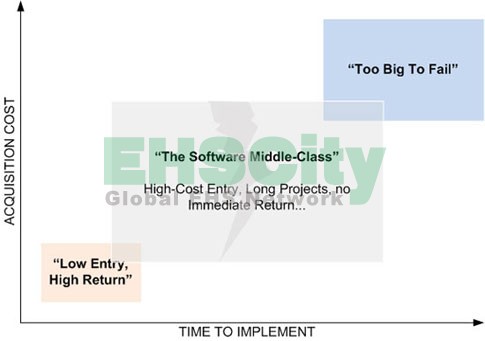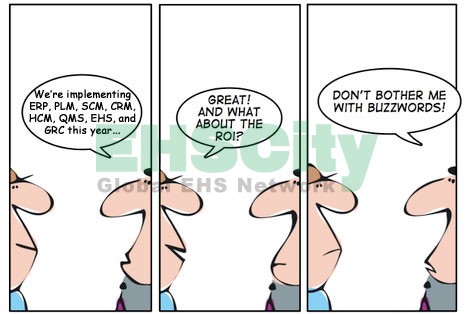Let’s dispel any misconceptions first: Software is not just a tool; it’s an investment. Quality and EHS management solutions require upfront costs, as well as upfront effort, to get them up and running, and the returns come only after you’ve put financial investment into the product and its implementation. The key is how quickly you expect to see a return.
In this market, ROI must happen quickly. We have entered a time when IT departments are cutting budgets and looking for ways to consolidate and integrate business systems. As such, IT is looking for ways to cut systems that drain resources, protect budgets for larger-scale implementations, and seek out low-cost alternatives. Chief information officers (CIO) are looking for ways to demonstrate immediate ROI on projects—which often means seeing returns within a quarter. This has had an effect on the “software middle class,” those systems that are high-cost with long timelines to ROI.
You have three real scenarios in this IT solution model:
1. The “too big to fail.” These are the long-term, high-budget projects that are simply too big to abandon or too critical to the business to scale back. SAP is a prime example. The solution touches so many parts of the business, and has so much at stake to the success of IT, that it will never be scaled back or abandoned.
2. The “software middle class.” These are specialized solutions that serves a singular need (or the needs of a few), but come at a high price of entry and no definable ROI in the near future. These are solutions that come onto the chopping block as departments look for lower-cost alternatives.
3. The “low entry, high return.” These are specialized solutions that have carved out their niche in a particular function and have certain “out of the box” qualities that give them low entry costs. Due to their configurable natures and flexibility, they can yield a faster ROI than their middle-class cousins.

So, what does this mean for quality and environmental health and safety (EHS) solutions? Well, it means that companies are looking for more value from their systems; QMS and EHS solutions are expected to do more and provide more immediate value. The CIO will look at their infrastructure and say, “Can my too-big-to-fail systems handle the processes we need, and if not, what systems can we put in place that will integrate with these systems and provide me with quick ROI?” Quality management systems (QMS) and EHS are prime examples of systems that accomplish this goal.
Here’s what these systems offer:
1. Workflow and business process automation. Look for a system that has the flexible workflow to not only accomplish the tasks of quality and health and safety, but also provide value in all business process initiatives. Can the system be configured to do more for the organization? Leading systems integrate PLM, and SCM features into quality, and add sustainability to EHS that the software middle-class once handled; this provides additional value to the system and makes it a lower-cost alternative to these middle-class systems.
2. Integration capabilities. Again, the CIO will ask whether the “big project” systems like SAP can handle the process, and if it can’t, then whether it can be integrated with these QMS and EHS systems. Look for solid and certified integration points that will enhance your too-big-to-fail systems. Leading QMS and EHS systems offer various levels of integration—enough to fill the gaps that are necessary to round out the infrastructure.
3. Immediate value. When looking at these systems, the time it takes to realize the ROI is critical. The nature of QMS and EHS systems is in their configurability: They are inherently built to be configured quickly and adapt to changing processes with little to no programming or custom development. This enables them to provide value within a short span of time.
4. Definable ROI. This one is tricky. How do you define ROI? Many companies look for quantifiable ROI but often have no baseline with which to compare it. Because many organizations aren’t tracking ROI metrics on a particular software solution, they seek ways to determine how much value a QMS or EHS system will provide. Here are some sample cases where ROI is provided on QMS and EHS systems:
• Time savings: The nature of workflow-based automated quality and EHS is that it reduces the cycle time to complete otherwise manual processes. One organization had a quality control process that took upwards of 45 days to complete a cycle in a manual process. This was due to diverse locations and compiling data from various sources. Using automated solutions, the QC process was reduced from 45 days to a single day. Although not immediately quantifiable, the time savings is staggering.
• Systems consolidation: Creating a centralized resource for quality and safety is important to demonstrate value. Another company had a diverse portfolio of business systems that managed its processes. This would grow over time as new divisions adopted business processes. At its high point, the company had more than 700 business systems driving processes, with various levels of complexity. Using a single, holistic solution, it was able to reduce the number of systems from 700 to one. This alone saves time and money in maintenance, but also provides a more efficient method of tracking quality and safety.
• Administrative overhead: Manual or cumbersome processes take up resources. Whether this is in man-hours, administration time, or physical bodies, this is time spent on the system rather than the business. One such example came when an organization purchased a system to manage audits. The system enabled it to automatically schedule audits. This reduction in time and overhead resulted in a resource savings equal to five full-time employees, who are now freed up to do work more valuable to the business.
So, ROI is all in how you perceive value in the system. Look for a solution that not only is able to provide value in a short period of time, but also demonstrates the value in a way you can relate to your organization. The above are just specific examples; you could use these as a starting point but will have to determine your own metrics based on your unique business needs. The takeaway is that ROI comes in all shapes and sizes. Leading QMS and EHS systems provide the low-entry, high-value mix, and are prime examples of gaining ROI in a short period of time.


